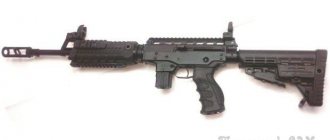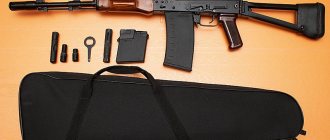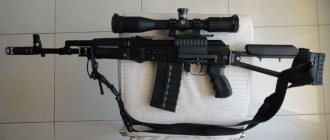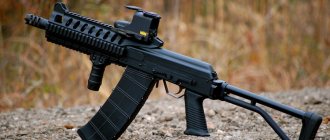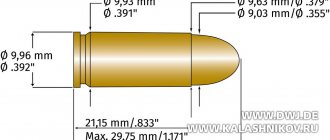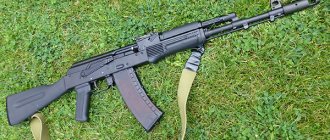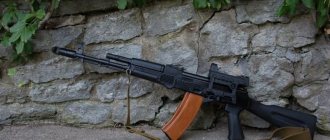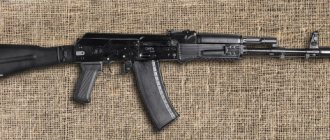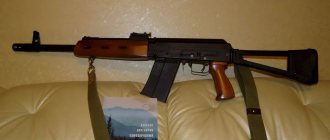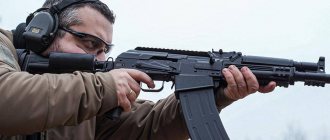The history of the creation of the Saiga 9 carbine
This carbine is a representative of a large family of civilian weapons produced by the Kalashnikov concern. Its history began in the late sixties and early seventies. At this time, the party leadership of Kazakhstan raised the question. That the number of saigas in the steppes is increasing uncontrollably. Shooting them with traditional hunting weapons turned out to be ineffective.
The issue was put on the agenda, and instructions were given to develop new models of civilian weapons, called “Saiga”. Work on new models was carried out by adapting military weapons in accordance with legal requirements. At first, it was planned to use foreign ammunition, but soon their production was mastered by the Tula, Krasnozavodsk and Barnaul factories.
It includes both smooth-bore and rifled weapons of various calibers. The first developments appeared in 1974. Weapons were produced in small quantities in the coming years. In the early nineties, the Izhevsk plant experienced difficult times. In order to support the enterprise, it was decided to increase the production of civilian weapons and continue to develop new models.
Work on the Saiga 9 carbine continued for three years. The release of this model created a lot of anticipation. Many wanted to purchase a new Russian brand of weapon as soon as possible, hoping that it would embody the best properties of the famous Kalashnikov assault rifle. But there were also those who believed that the carbine could not be of high quality, due to strict legal requirements for civilian weapons.
The Saiga 9 carbine went on sale in 2014. Contrary to the predictions of skeptics, this weapon was extremely popular - it was almost immediately swept off the shelves. At first, its production was insufficient: the first three batches were sold out immediately. Many gun lovers could not make a purchase and contacted the concern to find out the prospects for the production of this carbine. Since mid-autumn, Saiga 9 began to regularly appear on shelves in sufficient quantities.
Performance characteristics of the Saiga 9 carbine
| Characteristic | Parameter |
| Caliber | 9 mm |
| Barrel length | 345 mm |
| Barrel type | threaded |
| Ammunition type | 9x19 |
| Magazine capacity | 10 |
| Weight without magazine | 3100 grams |
| Length with stock folded | 610 mm |
| Length with stock unfolded | 830 mm |
Saiga 9 is a rifled weapon that uses combat pistol cartridges. Outwardly, it resembles an AKS-74U assault rifle, which appeals to many. In the series of rifled carbines of the Kalashnikov concern, this is the only such model. An important feature of the carbine is the low cost and availability of the cartridges used.
The recoil is very weak. To reduce its magnitude, you need to hold the weapon correctly when firing.
Execution options
The Saiga-9 rifled carbine can be presented in several versions: a limited series of carbines chambered for the 9×53 mm cartridge (produced in 2001–2005) and a series of carbines chambered for the 9×19 Parabellum cartridge based on the PP-19-01 Vityaz- SN (sp. 02).
Models that are exported are distinguished by the absence of an additional safety system - a shot can be fired even with the butt folded, and options are offered for the 9x21 mm cartridge. There are also versions equipped with sights or an under-barrel body kit, but their cost leaves much to be desired. The Russian buyer mainly uses those versions that are simple and have a low price tag. Well, collectors will be delighted with the one-piece versions with gold-plated triggers or a stock made of expensive wood.
Sports version of the Saiga-9 carbine with a tubular fore-end
The structure of the carbine
The Saiga carbine is a distant descendant of the famous Kalashnikov assault rifle models. He inherited the simplicity and reliability of the design, and the quality of shooting. The immediate predecessor was the Vityaz submachine gun, taking into account the fact that burst firing in a civilian carbine was disabled.
Compared to the mentioned model, the barrel was made longer. This change was due to the need to comply with legal requirements, which stipulate a minimum length for civilian weapons, as well as a lock that makes it impossible to fire with the butt folded.
Changes have been made to the muzzle compensator; the strip used to attach the body kit is missing. Recharging is performed automatically. This makes it possible to fire consecutive shots simply by pressing the trigger several times in a row.
The stock is folding. It is fixed by the “mushroom” protrusion. In the receiver, the neck for the magazine is plastic. It is made massive and durable. To secure the magazine, a latch is not used - for this purpose, a special protrusion is used, into which the part rests with the front, upper part. Removal and insertion occur in a straight line, which makes working with the magazine more convenient.
It can hold 30 rounds of ammunition for military use. For the civilian version, a limiter is installed. Allows you to place 10 rounds.
The trigger mechanism of the carbine uses three axes. The work uses a self-timer. Its use is relevant for the following reason. The weapon uses a blowback action. It is necessary to eliminate the risk of a shot when the bolt is not closed in the forward position. When it has 2-3 mm of travel left, the self-timer releases the trigger. This eliminates the risk of a shot being fired when the shutter is not closed.
The trigger mechanism almost completely copies the one used in the AKS-74U assault rifle. The sear, trigger, mainspring, hammer are so similar. Which apparently were taken without changes from production models of such submachine guns.
The carbine does not use a trigger retarder, which is used in the Vityaz assault rifle. Instead, a travel limiter is used, which was used in the AKS-74U model, but in the carbine it is made lighter and more miniature.
The trigger is made with a straight feather. Blocking a shot with the stock folded works like this. When the stock is in the folded position, the protrusion on it fits into a hole located on the back of the trigger block, preventing its movement. In such a situation, there is no way to press the shutter.
If the hammer has been cocked, then in the folded position you can remove or insert the magazine. When the trigger is pulled, the bolt cannot be moved to the rearmost position. The buttstock can be folded no matter what position the safety lever is in. As soon as it is moved to the working position, the firing block will be stopped.
The aiming bar can be adjusted according to the firing range. There are 4 divisions: 50, 100, 150, 200 meters. This sight is convenient to use when quickly throwing up a carbine. A Picatinny rail is used. It allows you to install an additional sighting device.
The extended barrel increases the accuracy of shots and accuracy of fire. The bore has a chrome-plated surface. It provides the opportunity to use domestic cartridges with bimetallic bullets when shooting from a carbine.
This weapon model has relatively low recoil. The design of the used muzzle brake-compensator allows it to be further reduced. In this case, the toss is almost completely absent.
When creating the Saiga 9, a modernized receiver from an AK assault rifle was used.
At the same time, the layout of the bolt frame was preserved. The use of a massive blowback bolt helps create high stability when shooting. The weapon's high metal content helps dissipate heat more effectively when fired. The carbine uses a longer holding handle compared to its predecessor. It is a little thin, but allows a shooter with gloves to hold the weapon comfortably.
The used automation operation scheme was chosen taking into account the use of a low-power cartridge. The principle of its operation is as follows. The bolt does not completely lock the barrel at the moment of firing. It performs the action to the extent necessary to block the critical shift of the spent cartridge case when the bullet is ejected. The remaining gases are used for recharging.
This operating scheme eliminated the need to use a butterfly valve. Also, there is now no need to operate a gas outlet channel of the barrel and a special gas piston. This tube still retains its appearance, but now it has a purely decorative function, allowing the carbine to retain its similarity to certain models of Kalashnikov assault rifles.
Operating principle
The operating principle of the automation of the Saiga carbine completely repeats the principle of operation of the automatic Kalashnikov assault rifle. The only exception is the trigger, which is upgraded to fire only single shots.
The Saiga carbine is reloaded automatically, using the energy of the powder gases removed from the barrel.
- When you press the trigger, the trigger is released, which, striking the cartridge primer with its striker, ignites it, and a shot occurs
- During a shot, part of the powder gases, through a hole in the upper wall of the barrel, enters the gas chamber
- In the gas chamber, powder gases exert their pressure on the gas piston, which sets in motion and forces the bolt frame to move backwards
- The bolt is unlocked, the cartridge case is first released from the chamber, then the spent cartridge case is ejected to the right through the window in the receiver by a spring-loaded ejector and receiver reflector, the bolt frame compresses the return spring and cocks the hammer into the firing position
- Under the action of the return spring, the bolt returns forward, sends a new cartridge from the magazine into the chamber, and turning around its axis locks the bore and closes the bore. The carbine is ready for the next shot.
Advantages and disadvantages of the model
Advantages and disadvantages
Reliable and high-quality weapons.
Weak recoil.
Automatic recharge.
The presence of a Picatinny rail, which makes it possible to install an optical sight.
The effective firing range does not exceed 100 m.
After a shot, powder gases may enter the face. There are very few of them, but they are felt well.
When shooting, contamination occurs inside the receiver.
The main use of this carbine is the use of weapons for sporting or recreational purposes. It is used less frequently for hunting. It is possible to additionally use a muffler. To do this, it must be certified.
This weapon has very low recoil. This is one of the factors that contributes to its high popularity. This is facilitated by the relatively high mass of the weapon and the ergonomic design of the butt. This is also influenced by the choice of cartridges used. Nine-millimeter guns have a relatively small powder charge, which reduces the force of impact when fired. In addition to reducing recoil, this makes the weapon safer to use, reducing the risk of accidental injury.
Recharging is performed automatically. You can empty the entire magazine in no more than 5-6 seconds. The weapon is more ergonomic compared to other models of the Kalashnikov concern.
When shooting at low temperatures, touching metal parts while aiming will cause your cheek to become very cold, causing discomfort. When firing, combustion products may get into your eyes. Therefore, it is recommended to shoot while wearing safety glasses.
When shooting, dirt appears in the receiver. During use, the cleaning rod may sometimes pop out of the mount.
The effective combat range of this carbine does not exceed 100 meters. You can shoot at a greater distance, but this reduces the accuracy of fire.
The following can also be noted as advantages of Saiga 9:
- This weapon has an affordable price, making it available for purchase by almost everyone.
- Reliable safety switches are used.
- The barrel bore and cartridge box are protected from rust due to the presence of a chrome plated finish.
- Magazines made of impact-resistant plastic are used.
- The end of the barrel has a thread that allows you to install additional accessories.
- The Picatinny rail available on the weapon makes it possible to install collimator, optical or diopter sights on the carbine.
Existing disadvantages
Alas, any non-standard solution that brings important advantages inevitably brings disadvantages, which are very important to know about. However, they have already been discussed.
Of course, first of all, this is a weak cartridge used. On the one hand, it provides good accuracy due to low recoil. But this also has a downside. A small amount of gunpowder leads to the fact that the force of the shot is quite small. Therefore, using a carbine for hunting becomes almost impossible. And the maximum combat distance here is not too great - much less than, for example, the Saiga-12.
In general, the shortcomings can be considered exhausted. At least technical ones. But also do not forget that the weapon is rifled. Therefore, it will not be possible to purchase it as easily as a smoothbore one.
Ammunition for the Saiga 9 carbine 9*19
When shooting, 9x19 cartridges are used. They are used all over the world and are also known by other names: 9 mm Luger, 9 mm Parabellum or 9 mm NATO. The initial bullet speed in this ammunition is 410 m/sec. There are several varieties of such cartridges. This ammunition has the following characteristics:
- bullet caliber 9.03 mm;
- the sleeve has a length of 19.15 mm;
- cartridge - 29.69;
- the weight of the powder charge used is 0.46-0.48 g.
The sleeves can be steel (copper-coated) or brass. The bullet is a jacketed bullet with a lead core. The shell is usually metal or steel, which has been clad with tombac. Throughout World War II, these cartridges confirmed their high reputation and became standard ammunition in most countries of the world.
Disassembling the gun
When using the Saiga 9 carbine, it is necessary to ensure appropriate care. To this end, the following actions are carried out:
- An external visual inspection of the weapon is performed.
- Cleaning must be done regularly. In this case, the weapon is completely or partially disassembled.
- Lubrication is carried out with special weapon oils.
During the shooting process, the sighting devices could be knocked down. They need to be checked and configured correctly. To perform cleaning, you need to prepare the following equipment:
- You need a cleaning rod, which is a metal rod that is used together with a special nozzle.
- Wiping is done in the form of a special cleaning rod attachment.
- Oil for processing metal parts.
- A screwdriver will be needed during the process of disassembling and assembling the carbine.
Cleaning should be carried out immediately after use at the first suitable opportunity. In this case, its serviceability can be guaranteed the next time it is used.
Immediately after purchasing the weapon, it is necessary to disassemble and clean it by removing the protective grease from the carbine mechanism.
Partial disassembly should be carried out as follows:
- It is necessary to prepare a place for work. This is best done on the table. If this is not possible, spread out a piece of clean cloth to lay out the parts. They are arranged in the order corresponding to the order of extraction.
- You must make sure that the weapon is not loaded. To do this you need to do the following. The store needs to be separated. Then turn off the safety and pull the bolt back. In this case, you need to inspect the chamber. After making sure that it is absent, send the bolt to the forward position.
- The bolt box is disconnected. To do this, grab the back of its cover with your right hand. At the same time, you need to recess the protrusion of the return mechanism in the rear part. After this, the lid is pulled back and slightly up, then pushed forward and turned until it stops. Now the return mechanism is separated.
- You need to disconnect the shutter. To do this, just move it back all the way. After this, it is separated from the receiver using an upward movement.
- Disconnect the receiver pad. To do this, the pin is turned upward until its groove coincides with the groove of the aiming block. After this, the lining is separated by moving upwards.
- To separate the forend, turn the pin of its ring 180 degrees and move the ring forward. After this, the forend is disconnected by moving forward and down.
- Now you need to separate the muzzle brake. You must first push the retainer inward using a drift. After this, the part is unscrewed.
When disassembled, the weapon is examined and the planned actions are carried out. After this, assembly is performed. In this case, all steps are repeated in reverse order.
